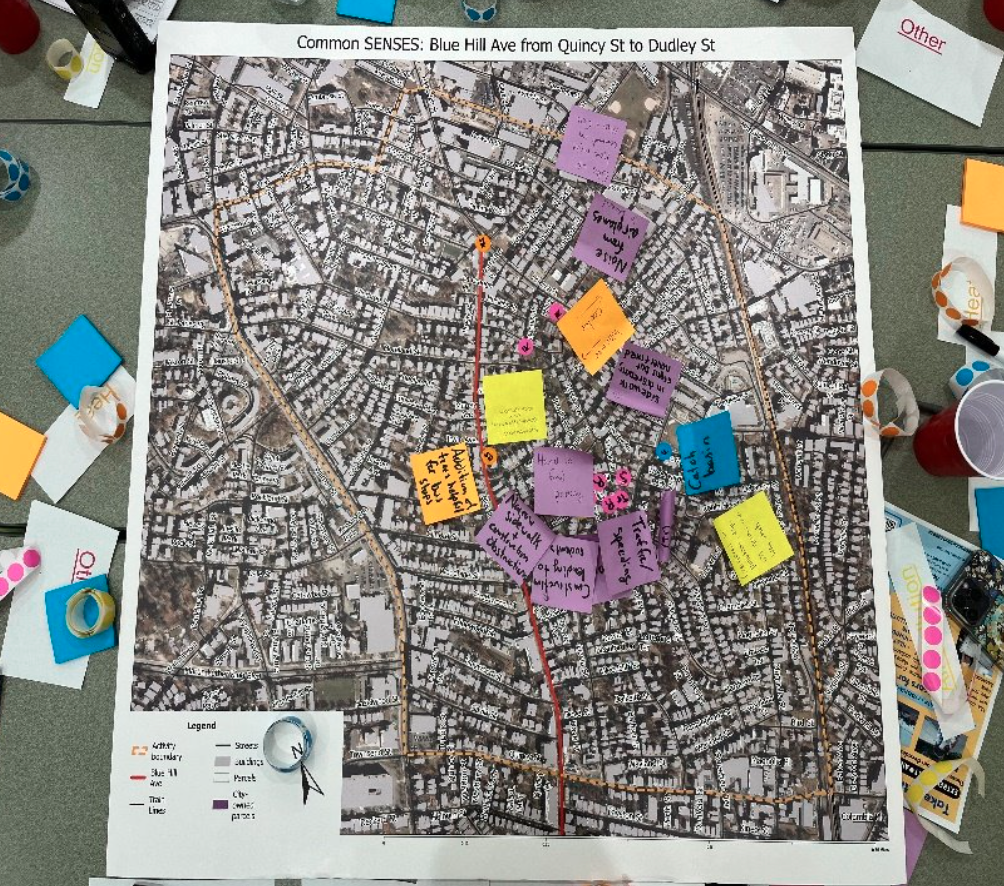Environmental Sensor Network on Blue Hill Avenue
A community-driven research project focused on improving environmental quality on the Blue Hill Avenue corridor.
The Common SENSES project brings together community members, university researchers, and City officials to address environmental hazards like extreme heat, noise, and air quality along the northern Blue Hill Avenue corridor. Using data from sensors that monitor street-by-street conditions, community members and project partners will develop targeted strategies for a healthier, more resilient Blue Hill Avenue corridor. The project is a collaboration between the City of Boston, Dudley Street Neighborhood Initiative, Project R.I.G.H.T. Inc, and Northeastern University.
The goals of the Common SENSES project are:
- Actively engage the community at every phase, from identifying areas of interest to data analysis and developing solutions together.
- Work with the community to deploy 50-60 sensors that measure heat, noise, and air pollution.
- Collaborate with the community to analyze the data, identify the underlying causes of differences, and use the findings to inform policy and planning, while also developing tools and resources tailored to the community's needs.
Sensor Network Locations
Timeline
PHASE 1: Identifying
Environmental Hazards
(September 2023 - July 2024)
Through workshops, community members identified the key environmental hazards negatively impacting the Blue Hill Avenue corridor as well as areas in the community that are comfortable and enjoyable to spend time in.
PHASE 2: Deploying Sensors
and Collecting Data
(August 2024 - May 2025)
Community members and project partners will co-design and deploy the environmental sensor network to identify block-to-block differences and the underlying drivers.
PHASE 3: Modeling
and Designing Solutions
( June 2025 and beyond)
Community members and project partners will co-design solutions and evaluate their potential impacts on the local community, drawing on community knowledge and collected data. The data will be used to create tools and resources that are tailored to the community's needs.
FREQUENTLY ASKED QUESTIONS
FREQUENTLY ASKED QUESTIONSAn environmental sensor is a device that monitors and measures different environmental variables. The City of Boston has previously deployed air quality sensors on street lights along Cummins Highway to understand the air quality before and after reconstruction. Community members played a key role in determining what environmental hazards the sensors along Blue Hill Avenue will monitor. These sensors will monitor air quality, heat and noise. Sensors will only collect environmental data and NOT identifiable information.
The first ten air quality sensors that will be deployed are from QuantAQ. The sensors provide measurements of PM 1, PM 2.5, PM 10, temperature, and relative humidity. More information about the air quality sensors can be found on the spec sheet.
Particulate matter (PM) is a mixture of solid particles and liquid droplets in the air that vary in sizes from so small they can only be seen through an electron microscope to large enough to be seen with your eyes, e.g., dust or smoke. There are different sources of particulate matter that include wildfires; pollen; car, truck, and bus emissions; and construction.
Yes, the sensors deployed as part of the Common SENSES project are designed to protect privacy. The sensors DO NOT collect any personal or identifiable data, such as video or audio recordings. The data collected is strictly focused on environmental hazards identified by community members.
Developing the locations for the sensors is determined by places of interest and reference locations.
Places of Interest
At four community workshops, community members identified local hazards including heat, air pollution, traffic, and more. The combined perspectives of the community members where visualized on maps that revealed "hotspots" or areas of greatest concern. During the summer, attendees at block parties used the maps to propose locations for the sensors. There will be more opportunities for community input on sensor locations in the Fall and Winter.
Reference Locations
It is essential that sensors are placed at reference locations like comfortable streets, parks, or other green spaces, as these locations typically tend to be cooler and have better air quality. The data collected from these locations will provide a baseline or a helpful comparison to the places of interest.
Events
EventsThere are no related events available at this time!





